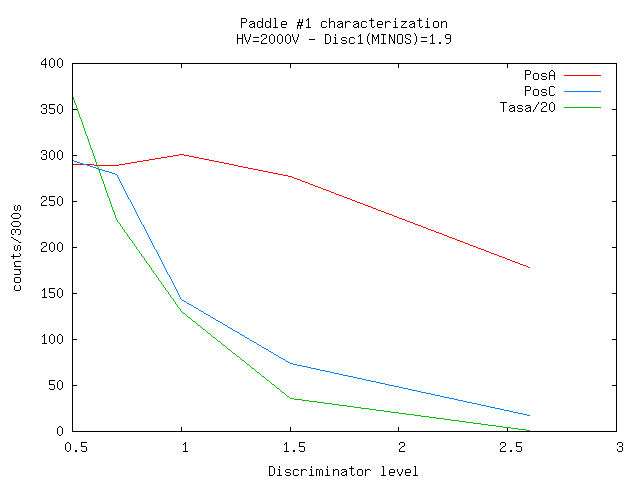Our muon telescope
Purpose
The prototype telescope was redesigned with the following purposes.
Replace MINOS scintillator bars in order to:
Enlarge the area of detectors to obtain a larger muon rate.
Fit the size of 15x15 cm2 TGCs.
Add a third detector to measure the muon lifetime.
Develop custom electronics to replace expensive NIM instrumentation:
Three channel discriminator for anode pulses.
Fast coincidence logic.
Data processing unit.
Maybe in the future, replace expensive PMTs with cheaper light sensors.
Using the recently developed technique (radical initiated bulk polymerization of styrene in glass die), three flat polystyrene scintillator paddles were built. Additionally, three cylindrical pieces of polystyrene were built in order to facilitate mounting.
The glass mold
Regular glass glued with FASTIX®.
| Glass Part | Size | Width |
| Cover | 18x6 cm2 | 2 mm |
| Base | 15x15 cm2 | 2 mm |
| Faces (4) | 35x15 cm2 | 2 mm |
| Sides (2) | 35x8 cm2 | 2 mm |
| Separators (6) | 10x5/2 cm2 | 10 mm |
| Small separators (3) | 3x2 cm2 | 10 mm |
The fabrication process
|
Glass jar for benzoyl peroxide drying (20 gr) and monomer mixing (2 litres). | |
|
The phosphors. | |
|
The clean glass molds. | |
|
Pre-heating of the mixture. | |
|
A clear result with blue shines. | |
|
Filled paddle mold. | |
|
Filled cylindrical molds (regular glasses). | |
|
Kept in the furnace for three days at 60-70ºC. | |
|
Ready. |
Unmolding & inspection
|
Imperfections do not represent a significant area... | |
|
... white light is guided... | |
|
... and ultraviolet light is shifted to blue. |
Isolation & mounting
|
First layer: adhesive PVC film (ORACAL 651)... | |
|
... in both faces and sides. | |
|
Second layer: heavy-duty aluminium foil. | |
|
Third layer: black cardboard. | |
|
Final cardboard layer and tape. |
Testing
|
MINOS bar (prototype telescope version) was used in coincidence with the new paddle for inspection. | |
 |
Click on graph for results. |
Similarly designed telescopes
- The Berkeley Lab Cosmic Ray Telescope Project
- The KTH Cosmic Ray Telescope
- Rochester Detector
- Penn drift tube detector (next?)
- The Fermilab Detector
